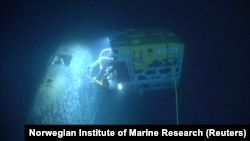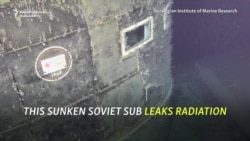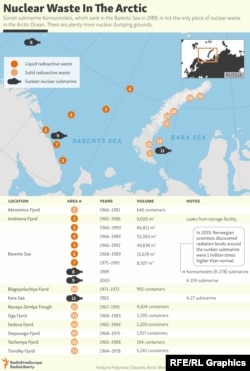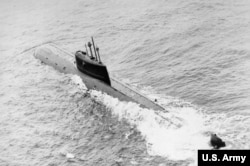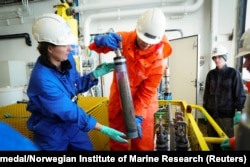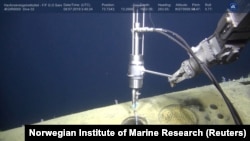The K-278 Komsomolets was on its first operational patrol when the Soviet nuclear-powered and nuclear-armed submarine met its fiery demise in the Barents Sea on April 7, 1989, killing 42 crewmen.
Thirty years later, a Norwegian scientific expedition to the wreckage site 1.7 kilometers below the surface has confirmed that the Komsomolets continues to have a lasting environmental impact.
"We found levels of radioactive cesium...that were close to 1 million times higher than the levels we find in [uncontaminated] seawater," Hilde Elise Heldal, a researcher from the Institute of Marine Research who participated in the July 7 mission, told RFE/RL by telephone.
The confirmation that the submarine is actively leaking radiation comes weeks after a fire aboard a top-secret Russian nuclear submarine in the Barents Sea killed 14 sailors, making it the deadliest submarine incident to hit the Russian Navy since 2008 and raising alarm about Moscow's transparency on the matter.
Norwegian scientists have been monitoring the wreck of the Komsomolets -- which lies 180 kilometers southwest of Norway's Bear Island and 350 kilometers northwest of the country's mainland coast -- since the 1990s.
The Norwegian monitoring effort entails annual expeditions to the Komsomolets to take water and core samples from the sea floor, but is limited, according to Heldal, because "we don't know exactly how close to the wreck we are."
WATCH: Sunken Soviet Sub Leaks Radiation. What Are The Risks?
This year, for the first time, the Norwegians deployed an underwater drone, the Norwegian-designed ROV Aegir 600, which she said, "made it possible to take pictures, film, and also to take samples very close to the wreck."
The results were both visually and scientifically stunning.
Video images released on July 8 revealed an eerie scene at the dark depths of Arctic waters -- twisted metal from the sub's scorched hull belying the Komsomolets' former status as one of the most advanced underwater vessels of its time.
Nuclear Torpedoes
Fitted with a titanium inner hull, a single pressurized-water nuclear reactor, and six 533-millimeter torpedo tubes that made it fit for antisubmarine warfare, the Komsomolets reached a depth of 1,020 meters in 1984, a record at the time.
But following years of development and testing after its commissioning as a prototype in 1983, its life as an operative vessel of the Soviet fleet was short-lived.
While conducting its first patrol at a depth of about 335 meters, a fire in the engine room quickly spread and caused the sub's nuclear reactor to shut down. The crew managed to carry out an emergency ascent and breached the surface within 11 minutes. But while most of the crew of 69 was able to evacuate, four died in the fire, while many who had managed to escape died of hypothermia as they awaited rescue.
After continuing to burn for hours, the Komsomolets sank to the bottom of the sea, carrying two nuclear-armed torpedoes with it. All in all, 42 crew members would perish.
In one of the last acts of the Soviet Union, investigators returned to the scene with manned submersibles in August 1991 to take samples and examine the wreck. The mission provided video images from inside the Komsomolets' hull and revealed that an explosion had occurred in the bow, which housed the torpedoes fitted with nuclear warheads.
In 1992, a second expedition including a team of scientists -- one of them Norwegian -- took extensive tests of water, bottom sediments, and organisms. But while the mission identified more extensive damage to the bow, nixing plans to try to raise the submarine, no hull deterioration or excess radiation was found, according to a document published by the U.S. Center for the Study of Intelligence (CSI).
It was not until 1993 that the detection of radioactive cesium-137 was reported. That Russian survey, which included Dutch, Norwegian, and American specialists, also discovered a massive hole in the forward torpedo compartment.
It was decided that the corroding torpedoes would be sealed in place the following year.
'Leaking The Whole Time'
Tengiz Borisov, who headed the Russian Special Committee for the Conduct of Underwater Work, told reporters at the time that "if there is a leak, fishing will be impossible in the Norwegian Sea for between 600 and 700 years," according to the CSI report.
A 1997 study by the Norwegian Defense Research Establishment on the sunken sub's effects on the environment found that "neither the submarine hull nor the reactor vessel will be destroyed by corrosion for at least 1,000 years."
Heldal said that participants in the recent expedition knew from "earlier, Russian, expeditions in the 1990s, and the last in 2007, that they had found leakage from one ventilation pipe of the wreck."
After taking five samples from the same pipe, Heldal said, various levels of radioactive contamination were found. One sample was not found to be above normal. One was 30,000 times higher than that found in uncontaminated seawater. Two samples showed levels 100,000 times more than normal -- in keeping with previous recorded samples. And one, she said, was close to 1 million times higher. Norway's Institute of Marine Research later specified that the highest sample was more than 800,000 times higher than normal.
Heldal described the findings as "comparable" to the results of previous Russian surveys, and said they showed that the Komsomolets had been leaking radiation "the whole time."
'Absolutely Safe'
However, she also said that while the latest results "may sound scary," she stressed that they were no cause for alarm. Any pollution is quickly diluted, she explained, saying that no radiation was found just a half-meter away from the ventilation pipe where the radiation was recorded.
She also said that scientific models had been made looking at what would happen if all the radioactive cesium on the Komsomolets was to leak out, and that even in that worst-case scenario it was "not going to have an impact on the fish in the Barents Sea because it is lying at such a great depth."
The pollution, Heldal said, was diluted on its way to the main fishing areas of the Barents Sea. The most dangerous scenario, she said, would be to try to raise the submarine and risk leakage at the surface.
"I can tell you from the monitoring we do on radioactive pollution and fish from these areas that fish and seafood from these areas are absolutely safe to eat," she said.




